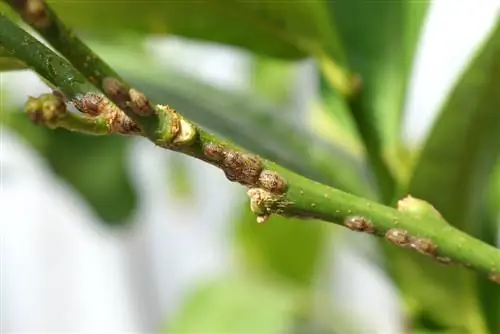- Author admin [email protected].
- Public 2023-12-16 16:46.
- Last modified 2025-01-23 11:22.
Of course there is great joy about every fruit you harvest yourself. But in this country, citrus plants are primarily cultivated for the eye. Therefore, it is desirable that the plant remains he althy and forms a beautiful crown. This can only be achieved through regular cutting.

How do you prune citrus plants correctly?
Citrus plants are best cut regularly and in moderation to achieve a beautiful crown. Make smaller corrections in summer, while larger thinnings should be done in late winter. Cut above buds or leaves that point outward, removing dead branches into he althy wood.
Subtle differences in citrus types
The term citrus plants includes lemons, limes, oranges, tangerines and many other species. They are all cut, but the extent and frequency of cutting can vary from species to species.
Tangerines, oranges and clementines, for example, form a densely branched and richly leafy crown. In order for enough sunlight to reach the fruits, they must be thinned out more often than the more loose branches of a lemon tree. Of course, the individual development of a specimen also influences the use of the scissors.
Cutting for a beautiful crown
The greatest motivation for cutting is the formation of an attractive crown. It should be dense, well-proportioned and occasionally spherical. Every cut stimulates branching. It's best to cut often, but only the tips of the shoots, so that the plant doesn't lose a lot of energy.
Tip
Lemon plants in our latitudes are usually only cultivated in large containers. But it is also possible to pull them on the trellis. Accordingly, they must be cut and tied from a young age.
Small corrections in summer
Minor corrections can be made to the citrus plants at any time during the summer. This is primarily about individual branches that become too large or otherwise no longer fit into the harmonious overall picture. They are simply shortened.
Major corrections in winter
More extensive pruning measures such as thinning out the crown are better carried out in late winter, before new growth appears at the tips. Because plants that are not in the growth phase are not weakened too much by cutting measures.
The months of February and March are ideal, while they are still overwintering indoors. If the plant needs a new pot, repotting should be done immediately after cutting.
Cutting instructions for winter cutting
- the cut can also go into old wood
- cut over buds or leaves that face outward
- then the new growth will also take place outside
- there is enough space for further branches
- Place the scissors about 3 mm above the leaf or bud
- cut diagonally, in the direction of growth of the leaf or bud
- remove dry and dead branches down to he althy wood
- Coat edges of larger wounds with tree wax
Tip
In autumn you can cut freshly woody shoots in order to propagate the citrus plant. The young plant develops and bears fruit more quickly than if its life began from a seed.
Sprout at the processing point
Purchased citrus plants are often grafted specimens. It can happen that new shoots appear below the grafting point. You should break this out early or cut it off close to the trunk with scissors.






